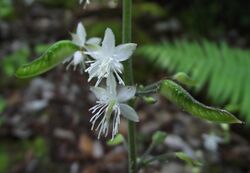Biology:Beesia
| Beesia | |
|---|---|

| |
| Beesia deltophylla | |
| Scientific classification | |
| Kingdom: | Plantae |
| Clade: | Tracheophytes |
| Clade: | Angiosperms |
| Clade: | Eudicots |
| Order: | Ranunculales |
| Family: | Ranunculaceae |
| Subfamily: | Ranunculoideae |
| Tribe: | Cimicifugeae |
| Genus: | Beesia Balf.f. & W.W.Sm. |
| Species[1] | |
| |
Beesia is a genus of flowering plants in the buttercup family. It was named in 1915[2] after the plant nursery firm Bees of Chester, who financed the plant hunting trips of George Forrest and Frank Kingdon-Ward in China.[3]
Species
There are two species of Beesia:[1]
- Beesia calthifolia, which is native to the following WGSRPD floristic regions: North-Central China , South-Central China, Southeast China, East Himalaya, and Myanmar.[4]
- Beesia deltophylla,[5] which is native to southeastern Tibet.[6]
Description
Morphology
Beesia is an evergreen perennial and grows as a dense basal rosette of heart-shaped leaves with delicate serrated edges. Leaves are soft and waxy; new growth of B. deltophylla flushes dark green to black, while B. calthifolia is a lighter shade of green. Small white flowers bloom mid-summer off an upright spike. Flowers are star-like: although Beesia flowers do not have petals,[7] they do have 5 elliptic, petal-like sepals.[8] Flowers also have many stamens.[8]
Phytochemistry
A class of organic molecules termed beesiosides have been isolated from Beesia plants.[9][10] Beesiosides are cycloartane glycosides (a type of triterpene that forms a sugar and a non-sugar upon hydrolysis).[9][11][12]
Phylogeny
Anemonopsis, a monotypic genus in the Ranunculaceae native to Japan ,[13] is a sister group to Beesia.[14][15] Eranthis and Actaea are also closely related to Beesia.[16]
Uses
Ornamental
Beesia is easily divided or grown from seed, and can be grown in USDA hardiness zones 6a to 8b. It grows best in partial shade or filtered light in rich, moist soil.
Medicinal
Beesia rhizomes are used in Chinese herbal medicine as a treatment for rheumatoid arthritis and influenza.[8]
References
- ↑ 1.0 1.1 "Beesia Balf.f. & W.W.Sm.". Kew Science. http://powo.science.kew.org/taxon/urn:lsid:ipni.org:names:33075-1.
- ↑ Greenman, J. M. (1916). "Current Taxonomic Literature". Botanical Gazette 62 (6): 509–516. doi:10.1086/331962. ISSN 0006-8071.
- ↑ Roy Lancaster Travels in China: A Plantsman's Paradise
- ↑ "Beesia calthifolia (Maxim. ex Oliv.) Ulbr.". Kew Science. http://powo.science.kew.org/taxon/urn:lsid:ipni.org:names:709225-1.
- ↑ "Index Nominum Genericorum (ING), Botany, Smithsonian Institution". https://naturalhistory2.si.edu/botany/ing/.
- ↑ "Beesia deltophylla C.Y.Wu". Kew Science. http://powo.science.kew.org/taxon/urn:lsid:ipni.org:names:709227-1.
- ↑ Zhang, R.; Guo, C.; Zhang, W.; Wang, P.; Li, L.; Duan, X.; Du, Q.; Zhao, L. et al. (2013-03-26). "Disruption of the petal identity gene APETALA3-3 is highly correlated with loss of petals within the buttercup family (Ranunculaceae)" (in en). Proceedings of the National Academy of Sciences 110 (13): 5074–5079. doi:10.1073/pnas.1219690110. ISSN 0027-8424. PMID 23479615.
- ↑ 8.0 8.1 8.2 "Beesia in Flora of China @ efloras.org". Missouri Botanical Garden. http://www.efloras.org/florataxon.aspx?flora_id=2&taxon_id=103691.
- ↑ 9.0 9.1 Ju, Jian-hua; Liu, Dong; Lin, Geng; Xu; Han, Bing; Yang, Jun-shan; Tu, Guang-zhong; Ma, Li-bin (2002). "Beesiosides A−F, Six New Cycloartane Triterpene Glycosides from Beesia calthaefolia" (in en). Journal of Natural Products 65 (1): 42–47. doi:10.1021/np010293p. ISSN 0163-3864. PMID 11809062. https://pubs.acs.org/doi/10.1021/np010293p.
- ↑ Ju, Jian-hua; Liu, Dong; Lin, Geng; Zhang, Yu-mei; Yang, Jun-shan; Lu, Yang; Gong, Ning-bo; Zheng, Qi-tai (2002). "Beesiosides G, H, and J−N, Seven New Cycloartane Triterpene Glycosides from Beesia c althifolia" (in en). Journal of Natural Products 65 (2): 147–152. doi:10.1021/np010294h. ISSN 0163-3864. PMID 11858746. https://pubs.acs.org/doi/10.1021/np010294h.
- ↑ "cycloartane (CHEBI:37778)". 30 January 2019. https://www.ebi.ac.uk/chebi/searchId.do?chebiId=37778.
- ↑ "glycoside", The Free Dictionary, https://medical-dictionary.thefreedictionary.com/glycoside, retrieved 2021-04-05
- ↑ "Anemonopsis Siebold & Zucc.". Kew Science. http://powo.science.kew.org/taxon/urn:lsid:ipni.org:names:33060-1.
- ↑ Ro, Kyung‐Eui; Han, Ho‐Yeon; Lee, Sangtae (1999). "Phylogenetic contributions of partial 26s rDNA sequences to the tribe helleboreae (ranunculaceae)" (in en). Korean Journal of Biological Sciences 3 (1): 9–15. doi:10.1080/12265071.1999.9647459. ISSN 1226-5071. http://www.tandfonline.com/doi/abs/10.1080/12265071.1999.9647459.
- ↑ Compton, James A.; Culham, Alastair (2002). "Phylogeny and Circumscription of Tribe Actaeeae (Ranunculaceae)". Systematic Botany 27 (3): 502–511. ISSN 0363-6445. https://www.jstor.org/stable/3093958.
- ↑ Yuan, Qiong; Yang, Qin-Er (2006). "Tribal relationships of Beesia, Eranthis and seven other genera of Ranunculaceae: evidence from cytological characters" (in en). Botanical Journal of the Linnean Society 150 (3): 267–289. doi:10.1111/j.1095-8339.2006.00477.x. ISSN 1095-8339.
External links
Wikidata ☰ Q3544894 entry
 |

